Sean McBride's Blog, page 5
February 23, 2023
Blind Read Through: J.R.R. Tolkien; The Book of Lost Tales, Part 1, Chapter 2: The Music of the Ainur
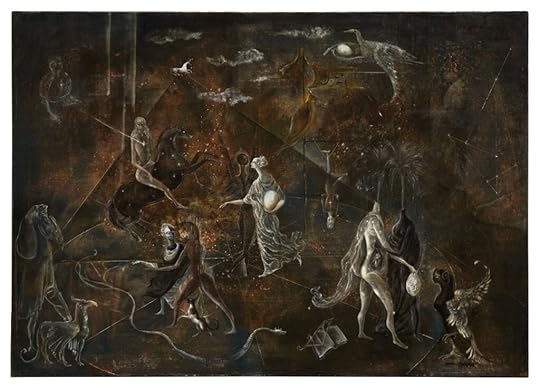 The Garden of Paracelsus by Leonora Carrington
The Garden of Paracelsus by Leonora Carrington“Then slept Eriol, and through his dreams there came a music thinner and more pure than any he heard before, and it was full of longing. Indeed it was as if pipes of silver or flutes of shape most slender-delicate uttered crystal notes and threadlike harmonies beneath the upon upon the lawns; and Eriol longed in his sleep for he knew not what (pg 46).”
Welcome back to another Blind Read! This week we head back to The Book of Lost Tales and tackle Chapter Two’s opening, “The Music of the Ainur.” Christopher added something new to this chapter from the notes of this father and the result sheds light on the meaning of the chapter. When he began writing Eriol’s story, Tolkien created a transitional piece between the beginning of the story of the Ainur and The Cottage of Lost Play. We’ll be covering that transitional piece this week because there is so much in it that warrants discussion before we move on!
Before we get too far into it, I want to delve a little deeper into the difference between Gnomes and Elves, which has been a strange adjustment because I wasn’t sure if Tolkien was calling all Elves (otherwise known as Eldar) Gnomes or if it was only Noldor (also known as Noldori) Elves. Part of the confusion comes in because of all the different names involved.
Tolkien wanted the world to be lush and complete, but because of who he was and his background, Worldbuilding to Tolkien didn’t mean delving into culture, landscape, or image. Instead, to Tolkien, what made people unique was how they communicated, meaning language. Thus, the language and the beings who utilized this language changed through his world’s creation.
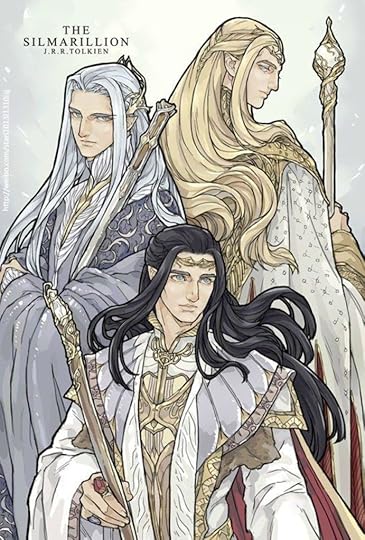
For example, the Teleri later become the Vanyar, The Noldoli (Gnomes) later become the Noldor, and the Solosimpi later become the Teleri. Why did he make all of these changes? Because of language.
The perfect example of this is what we began with: Gnomes. The word Gnomes brings to mind that small bearded garden variety with red pointy hats. I’m sure at some point in the writing of this epic; an editor approached Tolkien who mentioned that that word did not elicit that “They were a race high and beautiful… They were tall, fair of skin and grey-eyed, though their locks were dark, save in the golden house of Finrod (pg 44).” (just to be clear we are explicitly talking about the Gnomes or Noldor Elves. Christopher goes out of his way to make sure that is clear: “Thus these words describing characters of face and hair were written of the Noldor only, and not of all the Eldar… (Pg 44)“
So why did Tolkien call them Gnomes? Yep, you guessed it. Language! “I have sometimes used ‘Gnomes’ for Noldor and ‘Gnomish’ for Noldorin. This I did, for whatever Paracelsus may have thought (if indeed he invented the name) to some ‘Gnome’ will still suggest knowledge.”
In Greek, gnome meant thought or intelligence. Which then translated into words such as gnomic or gnostic. When Tolkien mentions Paracelsus, he refers to the 16th-century writer who used gnome as a synonym for pygmaeus, which means “earth-dweller.”
Tolkien was trying to establish that the Noldor were intelligent creatures who understood how the world worked. But he was also trying to create a distinction between the Noldor and the Valar. The two types of beings were almost interchangeable because they were both created by Ilúvatar.
At the beginning of this interlude, Eriol asks for clarification (Tolkien’s way of trying to clarify it himself): “Still there are many things that remain dark to me. Indeed I would fain to know who be these Valar; are they the Gods?” to which Lindo responds “So they be (pg 45).” And yet later, when describing gnomes, “nor might one say if he were fifty of ten thousand (pg 46).”

So he creates differences through the use of language. Both from the meaning of their names and the languages they speak. These themes also carry over into The Lord of the Rings because everyone has their distinct dialect, from Rohan to Gondor, from The High Elves of Rivendell to the woodland elves in Lothlórien. Here on Tol Eressëa, “there is that tongue to which the Noldoli cling yet – and aforetime the Teleri, the Solosimpi, and the Inwir had all their differences (pg 48).”
Language was a big theme in this introduction to make sure the reader understands what they are getting themselves into, but there are two other themes Tolkien stamps down, which carry over into all of his other writing; dreams and music.
All of these things are interconnected, and I chose the quote to open up this essay because it holds the essential themes Tolkien has brought into this tale.
If we remember from the first chapter (or go back and read it here), Eriol is a human of modern times. He travels and finds his way to Tol Eressëa, and he is a means to an end to tell the story of the beginning of time and the first age. What I find particularly interesting is that Tolkien intended there to be a “dream bridge” between Tol Eressëa and the rest of the world. So that outsiders could not find it while awake, and their knowledge of the isle would fade upon waking as dreams do; but dreams also leave us with subconscious memory, and feeling that stick with us, though we don’t remember details.
This intermittent chapter begins with Eriol heading to a room and falling asleep, and in that sleep, “came a music thinner and more pure than any he had heard before (pg 46).”
The Music of the Ainur, which we will get more into next week, is how the Valar (also known as Ainur) created the world. Their music brought into being plants, animals, and earth, as well as emotion and consciousness. This “pure music” is what Eriol hears in his mind as he sleeps. It is not the sound as it was when it created the world, but Tol Eressëa is so close to the center of everything that it echoes what came before. He hears the music of creation, and he doesn’t consciously recognize it, but he subconsciously melds into it.
I also find it interesting that he falls asleep and delves into dreams directly before being told the tale. Could it be that the entirety of The Book of Lost Tales is told through the Music of the Ainur while Eriol is sleeping?
Let’s see if we find out next week as we begin the Music of the Ainur!
February 16, 2023
Blind Read Through; The Fellowship of the Ring, revisited

“All that is gold does not glitter,
Not all those who wander are lost;
The old that is strong does not wither,
Deep roots are not reached by the frost.
From the ashes a fire shall be woken,
A light from the shadows shall spring;
Renewed shall be blade that was broken
The crownless again shall be king.”
Welcome back to another Blind Read! This week we take a nostalgic step backward and revisit an old classic, “The Fellowship of the Ring!” Though this is not quite a Blind Read, but it has been years since I’ve read these books. Years ago I remember reading them in preparation for watching the movies as they came out in the theater, so “some things that should not be forgotten, were lost” as it were.
I want to start this week by saying how much I missed when reading the books. They are jam-packed with history and I’m amazed at how well the novels were accepted at the time of publication because there is so much more you gain by reading the Silmarillion, which was published years after the original books were, and posthumously to boot. This time around the world seems so much more alive and complete than the first time because there is so much context present, just not explained. The world of Middle-earth is considerably more complex than the simple Hero’s Journey I had understood when I first read through it. But we’ll get into this in a minute.
In this essay, we’re only going to cover “The Fellowship of the Ring” as I’m going back through and re-reading the Lord of the Rings to gain a renewed experience after reading through the Silmarillion. Tolkien (according to his son and editor, Christopher) initially wanted to publish The Silmarillion in conjunction with The Lord of the Rings, and I can now understand why.
I remember reading the books some twenty years ago and being confused and turned off by the constant name-dropping and song, which didn’t make sense to me. I had no context to understand who Beren was, what Gondolin was, or why I should care about Eärendel. What I was missing was how full these details made the world of Middle-earth. There was a lush history beneath the surface, and I just hadn’t been privy to it to understand how that history created the world in which the characters lived. It truly makes all the difference.

The beginning of the novel has much the same charm as The Hobbit. It is evident that Tolkien had a much larger story in mind, but early on, the prose is more attuned to the “Children’s story” that was The Hobbit. It’s not until Tom Bombadil that that theme begins to change.
I remember hating Tom when I first read the books because, by his nature, he was always happy and highly overpowered. He and his wife dance around and make merry while some grave tidings are happening in the world, which is a significant call back to how Tolkien wrote The Hobbit. But the brilliance of this section of the book marks a change in the tone. Tom represents the last time in these books that the Hobbits needed rescuing when they don’t try to save themselves. In every other conflict in these books, after this point, the hobbits fight. Of course, they are outmatched at times as they need assistance, but against the Barrow Wight, they only wait for a savior instead of trying to do something about it.
Tom saves them and sends them on their way, and it’s at that point the merry-making and song end. Yes, there are many songs in the book beyond Tom’s section, but their tone is somber, and if you understand the history, they call back to the previous record and why the world has become what it has become. It even covers characters’ motivations, Like Aragorn, when he recites the Lay of Beren and Lúthien.
Later, when they get to the Council of Elrond, Tom Bombadil comes up again. They talk about potentially giving him the One Ring to protect it because he is so old and powerful. It seemed ridiculous when I originally read it, but after reading about the Valar and how they stayed out of the affairs of the Children (Men and Elves) it makes much more sense that they would try to get one of those powerful beings to protect it.
I was hoping to get more of a history of Bombadil in The Silmarillion, but how the Council spoke of him leads me to believe that he truly may be one of the Valar because of how he is described as too old and too powerful to care about the One Ring. If it was left in his care, he might forget about it or lose it. Gandalf, Saruman, and Sauron are all Maiar, so even beings of that power are indebted to, and scared of, the Ring’s strength. So Bombadil has to be one of the Valar who decided to stay on Middle-earth.
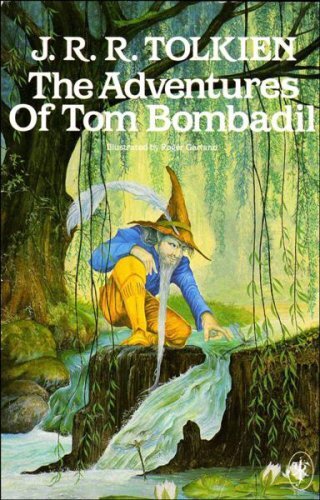
I look forward to reading his book (“The Adventures of Tom Bombadil”) when I get to it in the histories.
Bombadil doesn’t appear in the rest of the books, which leads me to believe that this was a transitional period in the novels. Tolkien wanted to keep his readership from the Hobbit, but he wanted to transition into something more meaningful and bold.
It isn’t until we reach Gandalf dying in Moria that the books finally feel much more realistic. The tone of the books shifts; the lays they recite are more lamentations than happy-go-lucky ditties that Tom Bombadil recites. The book shifts from a fun “children’s story” to a natural history of Middle-earth.
Elements of the Silmarillion are spread throughout the ending, but the stories they tell are direr and more immediate than what comes at the beginning. Tolkien does a masterful shift in the narrative from “Concerning Hobbits” to the “Breaking of the Fellowship,” We are left with desperation and an overwhelming desire to find out what happens to our friends in the next book.
As I mentioned above, when I read these books the first time I thought the whole point was to have a Hero’s journey, much like Joseph Cambell describes (though that is probably a whole series of essays to do at a later time). What we actually get is a wholly formed world. A World that is almost a character in and of itself. The characters are adding to that world and that history, but the book is not solely about them. It’s more about how their actions form the history of the world and not the other way around. I don’t think I’ve ever read a book that has such a deep and realized history before, and I have to say I’m enjoying Tolkien like I never had previously.
Join me next week as we jump back into the Book of Lost Tales, part 1, and review “The Music of the Ainur.”
February 9, 2023
Blind Read Through: J.R.R. Tolkien; The Book of Lost Tales Part 1, The Cottage of Lost Play Commentary

“I was from early days grieved by the poverty of my own beloved country: it had no stories of it’s own (bound up with its tongue and soil), not of the quality I sought, and found (as an ingredient) in legends of other lands. There was Greek, and Celtic, and Romance, Germanic, Scandinavian, and Finnish (which greatly affected me); but nothing English, save impoverished chap-book stuff (pg 22).“
Welcome back to another Blind Read! This week we delve into the commentary of Christopher and hear from Tolkien himself about the meaning behind the tale and why he told it.
Last week we touched on Tolkien’s feelings about the mythology of his native England. The quote above is from a letter he sent to his friend Milton Waldman, where he states he felt that there were no real fairy tales originating out of England. So “the primary intention of his work was to satisfy his desire for a specifically and recognizably English literature of ‘faerie’ (pg 22).”
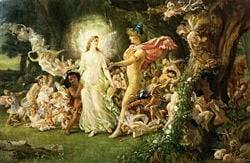
The idea of an old world filled with creatures great and small that was a precursor to our modern world swirled in his mind. In the beginning, “The story of Eriol, the mariner, was central to my father’s (Tolkien) original conception of the mythology (pg 22).“
The concept was to have Eriol find his way to a land of Faerie and learn some lost or archaic knowledge, which he would then report to the reader. This form is still in this “Book of Lost Tales.”
Tolkien started his (metaphoric) journey into Middle-earth with the basis in one of the oldest stories ever told – Beowulf.
This may seem strange because Beowulf has more history related to the Danes, but the first known translation of Beowulf is in Old English. Tolkien came to love the story because he was a linguist and one of his projects was to translate the tale from Old English. He took particular notice of the character Hengest, a sailor, traveler, and hero to the Thanes. Though Hengest only had a small appearance in Beowulf, Tolkien took notice. Again it was the language that garnered his interest, and we know this because Hengest and his brother Horsa’s names roughly translate to Stallion and Horse, respectively.
When Tolkien began to write his tales, not just translate those of others, he created Eriol; however, his original name was Ottor, and he used an old English name that meant wanderer. His father was Eoh which meant horse (of which he took from Hengest), and he had a very Cain and Abel relationship with his brother, Beorn. That name may sound familiar to those who read The Hobbit, as Beorn was the shapechanger.
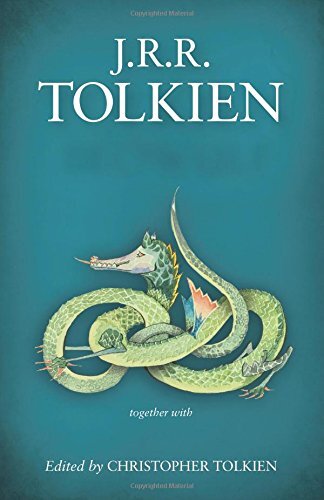
Tolkien uses some Germanic, Finnish, Danish, and Ole English names to evolve his language, which eventually became Elvish (though at the time of writing these “Lost Tales,” he called it Gnomish). The evolution of the tale coincided with the development of the language.
Christopher spells it out in the commentary, and it makes perfect sense. “But in the earliest conception he was not an Englishman of England: England in the sense of the land of the English did not yet exist; for the cardinal fact of this conception is that the Elvish isle to which Eriol came was England – that is to say, Tol Eressëa would become England, the land of the English, at the end of the story. Koromas or Kortirion, the town in the centre of Tol Eressëa to which Eriol comes in The Cottage of Lost Play, would become in after days Warwick [and in elements Kor- and War- were etymologically connected] (pg 24-25).“
So it could be possible that in Tolkien’s mind, Eriol was a Dane of the line of Hengest who went traveling for adventure and happened upon a strange land that would eventually be called England but was then called Tol Eressëa. He came upon it with surprise because it hadn’t been there previously, because Ulmo, the Valar who most loved Man (read that as humans), moved the island of Tol Eressëa from the bottom of the ocean. It’s possible Ulmo did this because of his love of Man, enabling Eriol to discover it so he could propagate the Lost Tales.
The difficulty with that is Tol Eressëa was an island just off the coast of Valinor, so how could Eriol travel to Tol Eressëa and not see or experience Valinor?
Because Tolkien created a unique device that has become a staple in most modern Fantasy, from Robert Jordan to Terry Goodkind. The Dream World.
Tolkien called it Olórë Mallë, otherwise known as the Path of Dreams. “After the description of the Hiding of Valinor, it is told that at the bidding of Manwë (who looked on the event in sorrow) the Valar Oromë and Lórien’s devising was Olórë Mallë, the Path of Dreams; by this road, when ‘Men were yet but new-wakened on the earth’, ‘the children of the fathers of the fathers of Men’ came to Valinor in their sleep (pg 27).”
Men could gain access to Valinor at the bidding of the Valar by dreaming, so why couldn’t Eriol get the stories from the Valar instead of The Cottage? I see two different reasons. One is the nature of dreams; when we dream, we tend to forget details when we wake, and the second is The Valar wanted to remain hidden. Also, if they could have everyone coming to Valinor through the dream journey, it would upset the balance of the Music of the Ainur.
It is the Children on Tol Eressëa who use Olórë Mallë the most often. When Eriol comes to the Cottage, they are all sleeping, and it takes a gong to wake them. I’d propose they are communing with the Valar and gaining power, morals, and purpose, which gets syamped into their being, though they forget about the communion upon waking.
Remember that Eriol’s father was one of these children at one point, so it would stand to reason why he felt called towards Tol Eressëa and the Cottage in the first place.
Though most of this is conjecture (much of which on my part), it makes sense, especially because “The ‘Eriol-story’ is among the knottiest and most obscure matters in the history of Middle-earth and Aman.“
Christopher goes on to say, “Those ideas can indeed be discerned from his notes; but the notes were for the most part pencilled at furious speed, the writing now rubbed and faint and in places after long study scarcely decipherable…(pg 23).”
Join me next week as well take a step back and review “The Fellowship of the Rings” and unveil and few surprises!
February 2, 2023
Blind Read Through: J.R.R. Tolkien; The Book of Lost Tales, Part 1, The Cottage of Lost Play

“Then said Lindo: ‘Of what shall the tales be tonight? Shall they be of the Great Lands, and of the dwellings of Men; of the Valar and Valinor; of the West and its mysteries, of the East and its glory, of the South and its untrodden wilds, of the North and its power and strength; or of this island and its folk; or of the old days of Kôr where our folk once dwelt? For that this night we entertain a guest, a man of great and excellent travel, a son meseems of Eärendel, shall it be of voyaging, of beating about in a boat, of winds and the sea (pg 18).”
Welcome back to another Blind Read! This week we begin The Book of Lost Tales, Part 1, with the first chapter, “The Cottage of Lost Play.”
This week we begin to see the history of Middle-earth through a story-telling lens. The book begins with a traveler, “a man of great curiosity, was by desire of strange lands and the ways and dwellings of unaccustomed folk brought in a ship as far west even as the Lonely Island, Tol Eressëa in the fairy speech, but in which the Gnomes call Dor Faidwen, the Land of Release, and a great tale hangs thereto (pg 13).“
This “man of great curiosity” is a man from England named Eriol, and he is the basis for all that comes after in this precursor to The Silmarillion.

Tolkien intended for the history of Middle-earth to intersect with our age, and this first section seems to be proof of that. Beyond the fact that the way Tolkien describes Eriol, it does seem as though he is representing himself. After all, Eriol learns the history of Middle-earth, and it would stand to reason that if Middle-earth was our world, Tolkien was only passing on the oral history of what he had “learned.”
That may not make sense right off the bat, so let’s break things down a little.
This chapter is about Eriol traveling from England to Tol Eressëa, an island off the coast of Valinor where the Teleri Elves lived. When Eriol gets to the island, he finds a small cottage in a field owned by a couple named Lindo and Vairë.
“Small is the dwelling, but smaller still are they that dwell here – for all who enter must be very small indeed, or of their own good wish to become as very little folk even as they stand upon the threshold (pg 14).“
Knowing that Eriol is an Englishman (despite that he seems to be from the Middle Ages), we see that Middle-earth is connected with our world, and the histories held within are our histories.
Indeed Tolkien even calls Eriol “a son of Eärendel (pg 13).” If you remember your Silmarillion history, Eärendil was the son of Tuor, a man and cousin of Turin Turambar and Idril of the Noldor of Gondolin. He eventually wed Elwing, who gave birth to Elros, who chose to be a man and became the ancestor of the Númenoreans. She also gave birth to Elrond, who we all know.
Tolkien isn’t calling Eriol Eärendel’s direct son but a descendant of him, proving that both our world and the world of Middle-earth are the same.
Lindo and Vairë, however, seem to be descendants of the shire folk, with their kindness and manners. They also are descendants of the Valar, as “He was of Aulë’s kindred (pg 16).“

They invite Eriol into their house, and soon there is a sound of a gong; “That is the voice of Tombo, the Gong of the Children (pg 15.).” The Gong calls the Children in from playing to come and listen to “the telling of tales (pg 15).”
Soon the tiny Cottage was regaled with the tales, and this is how we learn the history of Middle-earth – as it’s portrayed to Eriol.
But why did Eriol happen upon this Cottage? It was not a mistake:
“It had long, said he, been a tradition in our kindred that one of our father’s fathers would speak of a fair house and magic gardens, of a wonderous town, and of a music full of all beauty and longing (pg 20).“
The children who sat around at night would listen to these tales and eventually leave the island and the Cottage. These were the children of the Noldori and the Teleri (at this point, Tolkien was calling Gnomes. I’m not sure when he switched to Elves.), but they were descendants of Eärendel, which is who spawned the human race as we know it now.
Tolkien was a historian and linguist who was fascinated with how different cultures had similar roots. The origin of this Book of lost Tales was to explore these roots. The Lord of the Rings hadn’t blossomed in his mind (made apparent by his usage of Gnomes in this early iteration), and he wrote this chapter to explain this origin.
The Children who gathered around to hear these tales at Tol Eressëa became the people who started the different cultures which would eventually become our world. Tolkien even stamps that theory in the second to last paragraph, spoken by Eriol:

“Now these are tidings sad and yet good to hear, and I remember me or certain words that my father spake in my early boyhood. It had long, said he, been a tradition in our kindred that one of our father’s fathers would speak of a fair house and magic gardens, or a wonderous town, and of a music full of all beauty and longing – and these things he said he had seen and heard as a child, though how and where was not told (pg 20).“
Eriol’s father had left the island of Tol Eressëa. He remembered the stories, customs, and language, but he could remember nothing of the island itself. The Valar had hidden the island, and all that left it were doomed to forget about it.
They created an oral tradition formed into the Germanic languages and tales of North Western Europe. This also explains how the majority of the Hobbit and the beginning of The Lord of the Rings had so many songs and poems. Tolkien was trying to show how real the world was by including an oral tradition in story.
Tolkien’s purpose for telling these tales, even The Hobbit and The Lord of the Rings, was to explain why these traditions existed. Not only the language, which everyone assumes is why he created the history, but of the practices and mythologies of the region.
Join me next week as we delve deeper into “The Cottage of Lost Play” with Christopher’s Commentary!
January 26, 2023
Blind Read Through: J.R.R. Tolkien; The Book of Lost Tales, Part 1, Introduction
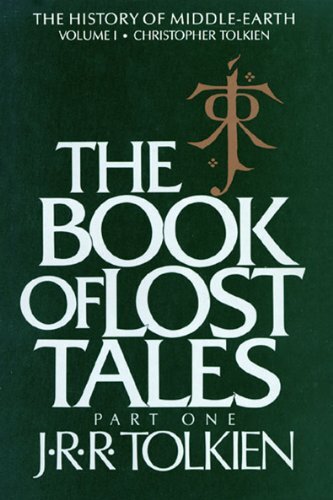
“As has now been fully recorded, my father greatly desired to publish ‘The Silmarillion’ together with The Lord of the Rings. I say nothing of it’s practicability at the time, nor do I make any guesses at the subsequent fate of such a much longer combined work, quadrilogy or tetralogy, or at the different courses that my father might then have taken – for the further development of ‘The Silmarillion’ itself, the history of the Elder Days, would have been arrested (pg 5).“
Welcome back to another Blind Read! We shift gears a little this week now that the Silmarillion is finished and jump into The Book of Lost Tales.
This week I wanted to review the Introduction, but in doing so, I wanted to check Christopher Tolkien’s words (John’s son and the editor of all of Tolkien’s estate since the publication of The Lord of the Rings). So this week will be a combination of analysis and opinion, even more so than any previous essay I have posted.
I’m going to cover two distinct points Christopher covers in the Introduction (there is more there, but for the purposes and desires of this blog, this is the focus). First, the difficulty of ‘The Silmarillion’ and John’s earlier works, and the novelistic approach versus the historical method through the evolution of ‘The Silmarillion’ from its earlier iterations versus Christopher’s edited publication. This last point is the tread that will bring us through the rest of the book and beyond.
“The Silmarillion is commonly said to be a ‘difficult’ book, needing explaination and guidance on how to ‘approach’ it; and in this it is contrasted to The Lord of the Rings (pg 1).“
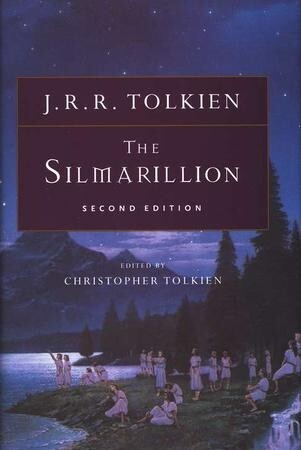
In this quote, Christopher is saying what everyone else is already thinking; this is why I chose to do a Blind Read with these books because they are notoriously tricky. The Silmarillion begins with a story similar to the Book of Genesis, which was difficult to swallow after concluding one of the most popular stories in generations. “This produced a sense of outrage – in one case formulated to me in the words ‘It’s like the Old Testament’ (pg 2)!”
Which this book is – at the beginning. Once Tolkien moves beyond the archaic origins of the beings and the world of Ëa, the language softens a bit because it becomes more attuned to exposition instead of an elegiac homily.
I contend that it’s Christopher who makes the language so difficult. He is the son of a language professor and is part of the English academic elite. His language is not the same as the language of the masses, which made the book (even when “stories are being told” like Beren and Luthien) considerably more difficult, as opposed to Tolkien’s The Hobbit or The Lord of the Rings.
That being said, we get an introduction to the original vision of the history of Middle-earth in “The Book of Lost Tales.”
“The letter of 1963 quoted above shows my father pondering the mode in which the legends of the Elder Days might be presented. The original mode, that of The Book of Lost Tales, in which a Man, Eriol, comes after a great voyage over the ocean to the island where the Elves dwell and learns their history from their own lips, had (by degrees) fallen away (pg 5).”
Tolkien wanted to tell his history, but he knew the difficulty of writing it as a historical book instead of a novelistic approach. But it was the novelistic approach with which he started. Tolkien began writing his histories before anything else (and the myth that the language developed and the book written to display that language is a misnomer. In the development of The Book of Lost Tales, we see the evolution of that language as he develops it over time.) in 1917. Tolkien wrote the history as if it were an oral tradition, which would alleviate some of the dry and dull exposition needed. It would stop the feeling of it reading “like the Old Testament (pg 2).“
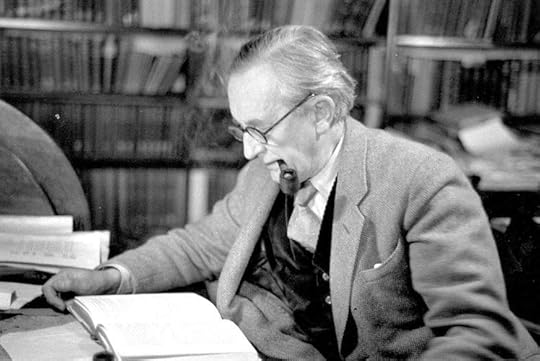
So instead of a dry history, we get the Human, Eriol, traveling to the Cottage of Lost Play and meeting Elves (they were Gnomes in 1917, though still called Noldor) who gather around a fire, much like you would expect Hobbits to do and regale Eriol with their story.
That makes The Book of Lost Tales interesting, even though it is a rehashing of The Silmarillion. We get to see the evolution of the design and approach of the work and how Christopher decided to edit it and publish it after his father’s death.
Christopher mentions that his father wanted this story told. The fact that we have so much material that calls back to The Lord of the Rings proves that Tolkien wrote to make the world whole. To be more than what Christopher calls “the mise-en-scéne of the story (pg 7),” Tolkien wanted people to know that there was history and agency behind the action in the book. That history led the characters to where they are when we pick up the events in The Fellowship of the Ring.
But does Christopher take it too far? On the contrary, it looks to me as though he uses his father’s platform to carve out a space for himself: “There are explorations to be conducted in this world with perfect right quite irrespective of literary-critical considerations; and it is proper to attempt to comprehend its structure in its largest extent, from the myth of its Creation.“
I agree with what Christopher is saying here. If he didn’t take the mantle over, there wouldn’t be The Silmarillion, and the world of Middle-earth would have stopped at The Lord of the Rings. However, what he did by taking things over was indelibly stamp his prejudice on the material.
Would The Silmarillion have been better as a story as it is in The Book of Lost Tales? Would that have garnered a more significant audience if it were a more accessible tale?
These are all questions I hope to get a better answer for through the next couple of books. Both The Book of Lost Tales, part 1 and The Book of Lost Tales, part 2, are the earlier iterations of The Silmarillion through the storytelling perspective. So these Blind Reads will be much more analytical than previous Blogs as we follow the creative process of Tolkien as both he and Christopher work to uncover the definitive history of Middle Earth.
January 19, 2023
Blind Read Through: J.R.R. Tolkien; The Silmarillion, of The Rings of Power and the Third Age, Conclusion

“In all the days of the Third Age, after the fall of Gil-Galad, Master Elrond abode in Imladris, and he gathered there many Elves, and other folk of wisdom and power from among all the kindreds of Middle-earth, and he preserved through many lives of Men the memory of all that had been fair; and the house of Elrond was a refuge for the weary and oppressed, and a treasury of good councel and wise lore. In that house were harboured the Heirs of Isildur, in childhood and old age, because of the kinship of their blood with Elrond himself, and because he knew in his wisdom that one should come of their line to whom a great part was appointed in the last deeds of that Age. And until that time came the shards of Elendil’s sword were given into the keeping of Elrond, when the days of the Dúnedain darkened and they became a wandering people (pg 296).”
Welcome back to another Blind read! This week we conclude the Silmarillion as Tolkien brings us up to date with the events of “The Lord of the Rings.”
We left off last week finding out how Minas Morgul came into being, and it was there, in the tower of sorcery, the last King of Gondor was held prisoner. He rode to the gates of Minas Morgul and challenged the Morgul lord to single combat but was betrayed and taken captive and never seen again.
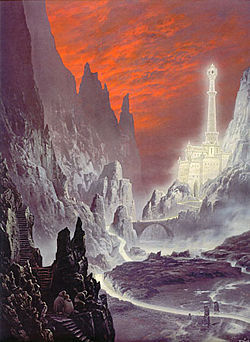
From that time forward, the horse lords of Gondor formed the Rohirrim, and the Stewards took over Gondor. These events led to the quote which opens this essay. Tolkien goes on to tell us that of the three Elven Rings of Power, Elrond took the Ring of Sapphire, Galadriel took the Ring of Adamant, and the Red Ring remained hidden, “and none save Elrond and Galadriel and Círdan knew to whom it had been committed (pg 297).”
What the Elves understood was that if someone found the Ruling Ring (otherwise known as the One Ring), then “the powers of the Three must then fail and all things maintained by them must fade, and so the Elves should pass into the twilight and the Dominion of Men begin (pg 297).“
The Elves passing into the twilight is what happens at the end of The Return of the King. The age of Elves had passed, and the ring’s power was gone. Many things didn’t change in the world, but Elves did leave once the One Ring was destroyed.
The only way that could come to pass is if Sauron found the Ring, or if someone else found it and destroyed it. Once Sauron woke and sought the Ring, a war against the Dark Lord was inevitable. But Elves, dwarves, and Men were not alone in their fight against Sauron: “Even as the first shadows were felt in Mirkwood there appeared in the west of Middle-earth the Istari, whom Men called Wizards (pg 298).“
These Wizards were Maiar, second only to the Valar, who sent them to Middle-earth from Valinor to assist in the fight against Sauron. “Chief among them were those whom the Elves called Mithrandir and Curunír, but Men in the North named Gandalf and Saruman (pg 298).“
Radagast was another Istari whom you might remember from The Hobbit movies, who came to Middle-earth at this time. “Radagast was friend of all beasts and birds, but Curunír went most among Men, and he was subtle in speech and skilled in all the devices of smithcraft. Mithrandir was closest in council with Elrond and the Elves (pg 298).“

The shadow continued to grow in Mirkwood, where Sauron returned to Middle-earth from Númenor. Mithrandir (Gandalf) was suspicious and went to Mirkwood and saw the signs, so he called the first White Council, “and therein were Elrond and Galadriel and Círdan, and other lords of the Eldar, and with them were Mithrandir and Curunír (pg 298).“
It was here that Curunír became chief of the council, and he “began to study the lore of the Rings of Power, their making and their history (pg 299).” It is here where Saruman began his fall from grace. The knowledge of the rings, and the study of them, corrupted him.
Gandalf went to Elrond and told him: “This is not one of the Ûliari, as many have long supposed. It is Sauron himself who has taken shape again and now grows apace (pg 299).”
Gandalf called for action against the Dark Lord. He asked that they move against him and try to capture or destroy him before he found the One Ring, “but Curunír spoke agianst him, and councelled them to wait yet and to watch (pg 299).“
They took his council, but they “were troubled, but none as yet percieved that Curunír had turned to dark thoughts and was already a traitor in heart: hor he desired that he and no other should find the Great Ring, so that he might wield it himself and order all the world to his will (pg 299-300).“
Saruman retreated to Isengard, and Elrond predicted to Gandalf that the Ring would be found again, which it was; “by a chance more strange than even Mithrandir had forseen. For it had been taken from Anduin long ere they sought it, being found by one of the small fisher-folk that dwelt by the River, ere the Kings failed in Gondor; and by its finder it was brought beyond search into dark hiding under the roots of the mountains (pg 301).“
Gollum had found the Ring. Tolkien spends the following few paragraphs describing the events of “The Lord of the Rings.”
The book ends with the revelation that Mithrandir “had long guarded the Red Ring of Fire (pg 302).” The third and final Ring of Power, entrusted to the Elves, was eventually given to Gandalf to assist in both hiding it and defeating Sauron.
It was also “in that time the last of the Noldor set sail from the Havens and left Middle-earth for ever. And the latest of all the Keepers of the Three Rings rode to the Sea, and Master Elrond took there the ship that Círdan had made ready. In the twilight of Autumn it sailed out of Mithlond, until the seas of the Bent World fell away beneath it, and the winds of the round sky troubled it no more, and borne upon the high airs above the mists of the world it passed into the Ancient West, and an end was come for the Eldar of story and of song (pg 303).“
It is a beautiful and lyrical ending to a beautiful and lyrical book. There are no better words than Tolkien’s to close out the book.
Join me next week as we jump into “The Book of Lost Tales Volume 1!”
January 12, 2023
Blind Watch: The Rings of Power; Episode 8, Alloyed
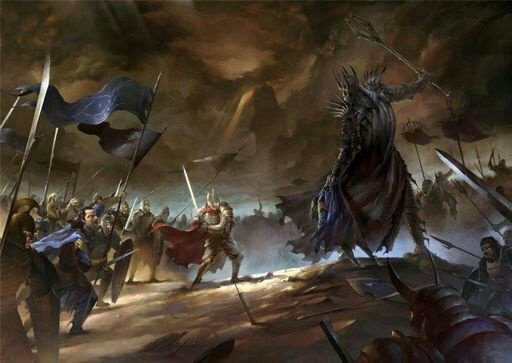
“I leapt from that ship because I believed in my heart that I was not yet worthy of it. I knew that somehow, my task here was not yet complete. And when I surfaced all I could do was swim and pray I had chosen wisely. I did not cross that bitter Ocean, onyl to drown now. And nor will I let you.”
Welcome back to another Blind Watch! This week we conclude The Rings of Power and close up all the messy and misused storylines.
There will be heavy spoilers in this essay, so if you have not watched the episode or show yet, please stop now and head back to Amazon and watch it!
This episode finally reveals who Sauron is as well as one other major character in the mythology.
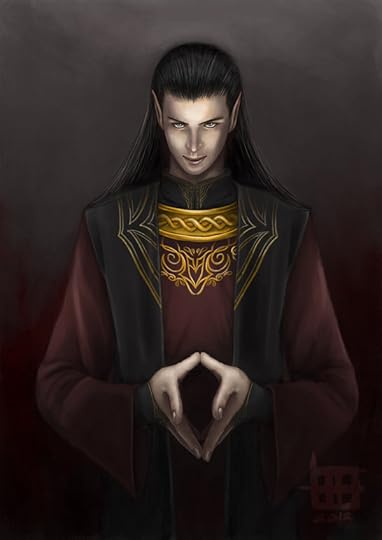
The show begins by having “the stranger” walking through the woods. He has been exiled from the wandering Hobbits (though they are not called that yet), and the mysterious and dangerous wanderers dressed in all white appear before him and all but tell him he is Sauron. Then, they use out-of-place magic to fool him, but the entire exchange doesn’t make sense.
First, let’s follow along with the show’s storyline and assume that this tall Stranger is, in fact, Sauron (he’s not, and we find out later who he is). It doesn’t make sense that Sauron wouldn’t know who he is at this point in history. He was already in Middle-earth from the end of the First age. The only time in Middle-earth’s history that it would make sense that Sauron might not know who he was (that never happened in any Tolkien I have read) was after the Drowning of Númenor, when he was cast down into the abyss, shed his mortal form and retreated to Barad-dûr. The fact that he shed his human form is the only factor in thinking he might not know who he was, so instantly, we see this Stranger is not Sauron.
What bothers me about this interaction is how lazy the writers were. Why would Sauron’s servants not know who he was? Especially servants who were this powerful in magic? Notwithstanding that there never were any magic users mentioned in Sauron’s entourage, these characters are just a means to an end to show the power of the Stranger and to show who he is, which is an Istari, otherwise known as a Wizard. Namely, this Stranger is who I thought he was all along: Gandalf the Gray.
It is Halbrand who turns out to be Sauron in disguise. I’m a little discouraged that I didn’t catch this sooner, but the writers changed the history so wholly to make it challenging to understand who he was, so I’ll give myself a little grace. Afterall, the whole point of this first season wasn’t to tell a wonderful story about Middle-earth, they wrote it to hide who Sauron was and to make a dramatic reveal.
To met he problem isn’t that Sauron turned out to be Halbrand. Sauron did, after all, disguise himself to influence the making of the Rings of Power. In the Silmarillion, he disguises himself as Annatar, the Lord of Gifts, to control the Noldor Elves and influence them create the rings in the first place.
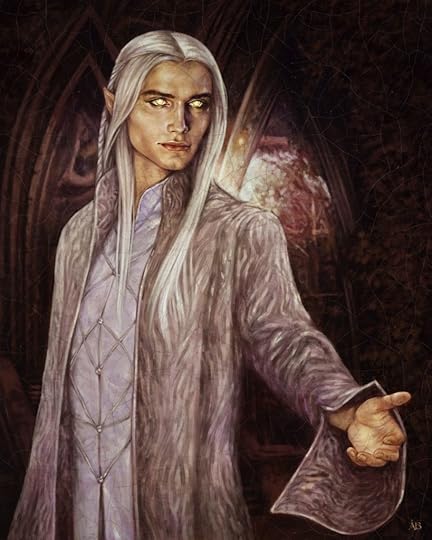
Elrond and Gil-Galad suspected Annatar was not who he said he was, so he left Lindon and went to Eregion, where they crafted the Rings. But, unfortunately, while they were making all the Rings of Power (not just the three for the Elves), Sauron retreated to Mount Doom and created the One Ring to rule them.
So the fact that the showrunners decided to change Sauron’s disguise from Annatar to Halbrand is acceptable. My problem comes in with how they introduced and framed him. Sauron is a master of deception, so much so, that he destroyed two different empires with influence alone (meaning that he didn’t raise an army against them).
But why was Sauron stranded on a raft? Do the showrunners want us to believe that he foresaw Galadriel jumping off her boat and swimming to a broken-down ship in the middle of the sea? And even if that was the case, there are far easier ways for him to ingratiate himself within the Elven culture.
Having Halbrand come up with such a soft cover as “King of the Southlands,” which was so easy to figure out “bloodline was broken,” is unlike Sauron. It makes him seem weak and lazy, which he is not.
Not to mention that there never was a human king in Middle-earth before Númenor. They were all traveling bands who were subjects of the Elven Kings.
The whole point of the entire show wasn’t to make an incredible Lord of the Rings show, but to hide the information about who Sauron was so they could have that reveal in the last episode. All the character’s motivations were to hide who he was, all the action was to hide who he was, and all the plot was to conceal Sauron’s true identity. I don’t mind that the showrunners wanted to change history, however, it doesn’t thrill me. The fact that they very obviously sat around a writing room and said they wanted the final reveal to be who Gandalf is and who Sauron is, then framed the rest of the show around that is just lazy.
This is why people don’t like the show. It’s not necessarily how they changed history because, without a doubt, this story is different from Tolkien’s. It’s not the show’s visuals because the special effects are spectacular. It’s how the writers decided that one event was enough to drive eight episodes. It’s how they took away the agency of every character to fit in with some big reveal (which was pretty lackluster).
I’m not sure if I’ll be watching the second season, if and when it comes out, but it’s no longer a Tolkien show, so there will not be another Blind Watch covering the events if there does turn out to be a second season.
Thank you all for reading, and join me next week as we complete The Silmarillion!
January 5, 2023
Updates 01/05/23
Wow, what a year that was! I did not get anywhere near where I wanted to go in a writing sense, as work and life stuff enveloped much of my time, but it’s time for a new year, and it’s time for new resolutions. I received a typewriter and a new notebook for Christmas, which has invigorated my creative juices, so it’s time to get to work and get to some of these books I’ve been sitting on!
Elsie Jones Adventures:
The first three of these were already published traditionally, but the contract is up, and the rights have reverted back to me. So I’m going to self-publish and finally get this series out. So expect the first two in the series this year.
If you didn’t know, The Elsie Jones Adventures is a Chapter Book series suitable for kids 5-12. They follow Elsie Jones as she discovers a mysterious library and each book in the secret library pulls her into the plotline of that book, and she goes on the adventure with the characters! The series is filled with action and humor, but it also has lessons to learn along the way.
Book 1: Elsie Jones and the Book Pirates

In this first book, Elsie finds a mysterious library and enters “Treasure Island” by Robert Louis Stevenson. She meets some new friends and goes on a Pirating adventure, but also discovers there is a strange group trying to destroy the special books in the library. Follow along with her on an adventure to stop them!
Book 2: Elsie Jones and the Revolutionary Rebels
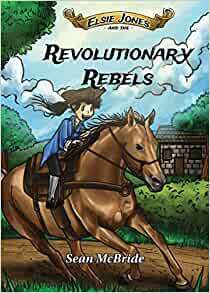
In Elsie’s second adventure, she finds an old book named “Common Sense” by Thomas Paine, which transports her to Revolutionary Boston. She meets Ben Franklin and goes on a famous horse ride with Paul Revere, leading to a showdown at the house of a literary giant.
Book 3: Elsie Jones and The Captain’s Guard

In Elsie’s Third adventure, she comes across “The Three Musketeers” by Alexandre Dumas and goes on an adventure with The famous French Musketeers. This book is filled with mystery, adventure, and swashbuckling fun, but it is on this adventure that Elsie realizes more is going on in these adventurous worlds.
You can find and purchase all three of these stories here or wherever books are sold. What will be released this year are “Author Editions” of these first three books. I wasn’t very happy with the end result when the publisher edited these books, so what you’ll get this coming year will be more extended and much more cohesive. The published books are still outstanding, don’t get me wrong, but since the rights have reverted back to me, I wanted to get the whole series out and make them as good as I possibly could. The originals still hold a place near and dear to my heart and will still be available.

Now onto other projects! As always, my first book of short stories is also available on this website or wherever books are sold. It is a group of short stories heavily influenced by the original “Twilight Zone” television show with Rod Serling. The title is “A View of the Edge of the World.”
The Legacy:
I read an article back in 2001 in Rolling Stone magazine about an island off the coast of Nova Scotia. I started writing an adventure novel back then but never got around to finishing it; then a History Channel show called “The Curse of Oak Island” came out, and it reinvigorated my love for this strange, mysterious island. I finished writing the novel in 2021 and meant to edit it in 2022 and get it out, but other things got in the way. I hope to finish editing it this year, get an agent and a publisher, and get it out early next year.
This book is based on Oak Island, but it is very much an “Indiana Jones” type story with heavy historical references which push the story forward as the characters look to uncover the mystery. It reads as half Dan Brown and half-pulp adventure novel. I absolutely love this book and can’t wait for people to read this one (and probably it’s sequels, wink, wink)!
The Revolution Cycle:
This is an expansive Fantasy/Adventure story. It follows a revolution from start to finish and will do so over a proposed 10 books. I’ve written the outline for the first novel and will be diving into it this year. I don t think it will be finished, but I hope to get enough done this year so it can be released by the end of next year.
Book 1. The Monster in the Woods
This first book of the cycle will focus on a group of young protagonists in a school in a secluded Duchy. They question the propaganda fed to them, and they drift apart until one of them finds a mysterious clue left by their strange uncle after he goes off to fight a monster roaming the woods outside the Duchy walls.
This book will have heavy Goonies vibes framed as a fantasy novel Joe Abercrombie would be proud to write. Each successive novel will expand the world and bring the characters further into the fight until they are inextricably involved with the revolution.
Future Works:
Elsie Jones and The Westward Adventurers: The fourth book in the Elsie Jones series. Elsie enters the world of James Fenimore Cooper’s “The Pathfinder.”
Elsie Jones and the Transylvania Twist: The fifth book in the Elsie Jones series. Elsie enters the world of Bram Stoker’s “Dracula”
Elsie Jones and the London Fog: The sixth book in the Elsie Jones series. Elsie enters the world of Sir Arthur Conan Doyle’s “The Casebook of Sherlock Holmes.”
Elsie Jones and the Dark Samurai: The seventh book in the Elsie Jones series. Elsie enters the world of Basho’s Haiku.
Elsie Jones and The Last Knight: The eighth book in the Elsie Jones series. Elsie enters the world of Cervantes “Don Quixote.”
Elsie Jones and the Treasure of Tut: The ninth book in the Elsie Jones series. Elsie enters the world of Virgil’s “The Aeneid”
I have written through the twelfth book in the series, but I’m keeping the remaining books under wraps!
I will continue publishing my weekly blog, which currently covers the histories of J.R.R. Tolkien. Each Thursday, I break down the verbiage and story to make the difficult language more accessible for the everyday reader. Check out my previous Blogs on The Silmarillion and all of H.P. Lovecraft’s work here!
You can also find other essays, short stories, and poetry here on my website for free, so I encourage you to read them! There is a good chance I will compile much of them for a future book of short stories, so get them while they are free!
The too far in the future projects:
The remaining books in the Revolution Cycle
A Sequel to The Legacy
Elsinore: A Graphic Novel about a town on the border of Hell
A future Elsie Jones spin-off
Thank you to everyone who follows and for your support for all who have purchased my books! Please continue to do so, and I hope the content I put out brings you joy, wonder, and happiness! Here is to a wonderful and prosperous New Year (with quite a bit of content coming your way)!
December 29, 2022
Blind Read Through: J.R.R. Tolkien; The Silmarillion, Of The Rings of Power and the Third Age, Part 3
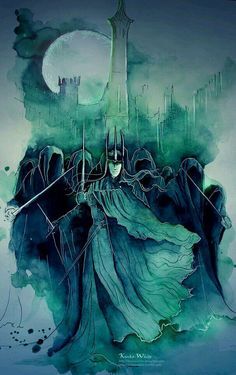
“Thus the Exiles of Númenor established their realms in Arnor and in Gondor; but ere many years had passed it became manifest that their enemy, Sauron, had also returned. He came in secret, as has been told, to his ancient kingdom of Mordor beyond Ephel Dúath, the Mountains of Shadow, and that country marched with Gondor upon the east. There above the valley of Gorgoroth was built his fortress vast and strong, Barad-dûr, the Dark Tower; and there was a fiery mountain in that land that the Elves named Orodruin. Indeed for that reason Sauron had not set there his dwelling long before, for he used the fire that welled there from the heart of the earth in his sorceries and in his forging; and in the midst of the Land of Mordor he had fashioned the Ruling Ring (pg 290-291).“
Welcome back to another Blind Read! This week we learn about the rise of Sauron and the beginnings of the downfall of the Númenórean lineage.
We left off last time learning how Isildur and Anárion built some of the most significant structures of Middle-earth, and we pick up this time realizing that “the malice of the Eye of Sauron few even of the great among Elves and Men could endure. (pg 291)“
We learn from the opening quote that Sauron took up residence in Mordor. He gathered great strength, recruited and bred servants, and expanded his empire beyond the firey mountain Orodruin; “and perceiving that Sauron had returned, the Númenóreans named that mountain anew Amon Amarth, which is Mount Doom. (pg 291)“

Sauron then used that great force to attack and sack Minas Ithil, “and he destroyed the White Tree of Isiluder that grew there (pg291).”
Isildur fled with a seedling of that great tree for a second time in his life and sought his father. Meanwhile, his brother held Osgiliath and drove Sauron back into the mountains, but “Anárion knew that unless help should come his kingdom would not long stand (pg 291).”
Elendil and Gil-Galad met with each other to come up with a strategy against this new Dark Lord. They decided that the only chance the people of Middle-earth had against his tyranny was to unite and make a stand. “Therefore they made that League which is called the Last Alliance (pg 292).“
Tolkien gives us two short paragraphs describing the events of this battle that rent the world. Every race had members on both sides, except the Elves, making it a struggle of kith and kin.
Gil-galad and Elendil fought valiantly and pushed Sauron back into Mordor, laying siege to his stronghold for seven long years. During these seven years in the fields of Gorgoroth, Anárion, Elendil’s son and Isildur’s brother died in battle. But it wasn’t until the last siege that Sauron himself came out to fight against his enemy, and “he wrestled with Gil-Galad and Elendil, and they both were slain, and the sword of Elendil broke under him as he fell. But Sauron also was thrown down, and with the hilt-shard of Narsil Isildur cut the Ruling Ring from the hand of Sauron and took it for his own (pg 292).“
Sauron, defeated, returned to shade form because he had put so much of his essence into the Ruling Ring. However, it was years before he took “visible shape (pg 292)” again. This victory marked the end of the Second Age of Middle Earth. The destruction of two great Kings and their powerful enemy ushered in a new age.
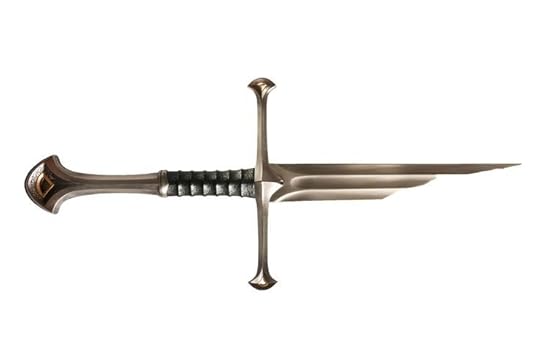
Isildur took the Ruling Ring for himself, and there was peace and prosperity for many years. Sauron’s minions were not wholly destroyed but reduced to a number Isildur was not worried about.
Isildur was not his father, though. “Never again was such a host assembled, nor was there any such league of Elves and Men; for after Elendil’s day the two kindreds became estranged (pg 293).“
Part of that estrangement came because Isildur refused to destroy the Ruling Ring, even upon the council of Elrond and Círdan. Instead, he took it as a token of success in dealing with the killing blow to Sauron and as recompense for the deaths of his father and brother.
Isildur went north to stake his claim to the throne in Eriador, his father’s seat, “and he forsook the South Kingdom (pg 293).” He set Meneldil, Anárion’s son, to rule Gondor in the south in his absence. To rule and to guard against the inevitable return of Sauron.
On Isildur’s trip north, he “was overwhelmed by a host of Orcs that lay in wait in the Misty Mountains (pg 293).” Unfortunately, Isildur was lazy because he deemed that he had won the war, so he didn’t set a guard when his caravan slept. As a result, the roving Orcs killed everyone except for three servants and Isildur, who escaped by slipping the ring on his finger and going invisible to his pursuers.
He jumped into the river, but “there the Ring betrayed him and avenged its maker, for it slipped from his finger as he swam, and it was lost in the water (pg 294).” With the ring off his finger, the Orcs could see him, and they filled him with arrows.

The surviving servants brought Narsil, Elendil’s broken sword, back to Imladris. But the sword was not reforged, “and Master Elrond foretold that this would not be done until the Ruling Ring should be found again and Sauron should return. pg 294)“
Over the beginning years of the Third Age, through war and isolationism, “the Men of Westernesse, the Dúnedain of the North, became divided into petty realms and lordships, and their foes devoured them one by one (pg 294).”
In the Southlands, the line of Númenor flourished for years under the leadership of Meneldil. They built immense structures and created the Gondor armor we are so used to seeing, but “the blood of the Númenóreans became much mingled with that of other men, and their power and wisdom was diminished, and their life-span was shortened, and the watch upon Mordor slumbered (pg 295).”
Eventually, a plague landed on them and killed the King’s lineage. They abandoned the border of Mordor and allowed evil to creep out of the boundaries. The evil took the shape of dark shadows. “It is said that these were indeed the Ulairi, whom Sauron called the Nazgûl, the Nine Ringwraiths that had long remained hidden, but returned now to prepare the ways of their Master, for he had begun to grow again (pg 295).”
They took Minas Ithil, Isildur’s former seat, and made it a place of dread and horror. “Thereafter it was called Minas Morgul, the Tower of Sorcery (pg 295).“
“But Minas Arnor endured, and it was named anew Minas Tirith, the Tower of Guard; for there the kings caused to be built in the citadel a white tower, very tall and fair, and it’s eye was upon many lands (pg 295).“
The stage is set, and the hallmarks of the Third Age are being revealed. Join us on the next Blind Read to see the resolution of “Of the Rings of Power and the Third Age.”
December 22, 2022
Blind Watch: The Rings of Power; Episode , The Eye
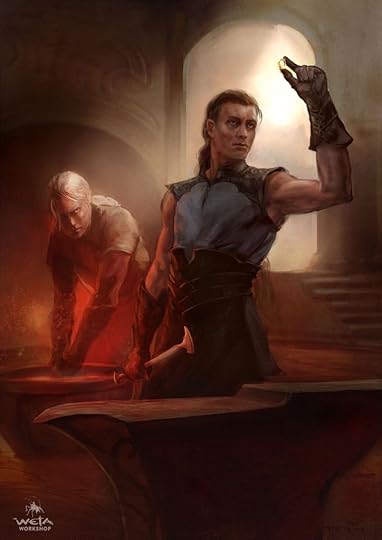
“We ask for something sacred in this mountain, and so we offer something sacred in return. In exchange for access to your Mithril mines, the Elves are prepared to furnish this city with gain, grain and timber from the elder forests of Eriador for the next five centuries.“
Welcome back to another Blind Watch! This episode and subsequent essay are strange because there is quite a bit of racism between the species, but not how you would necessarily expect it, and not how Tolkien wrote it.
Elrond speaks the opening quote of this essay to King Durin III towards the beginning of the episode. Unfortunately, the showrunners have changed the Elves’ history and relegated their fall to the Second Age of Middle-earth instead of the Third Age. In doing so, they have changed the relationships between the Elves and Dwarves of this age and made Mithril something it is not.
At this time in Middle-earth history, the Elves and Dwarves had a friendship, or if that’s too strong a word, they had peace and an understanding. For example, Celebrimbor and Durin worked together to create incredible weapons and armor using the Mithril. Likewise, Gil-Galad and Elrond had a deep friendship (which the show posits is only on Elrond’s side, Gil-Galad just uses him) with the Dwarves. Beyond the weapons and armor, they build fantastic structures for Elves and Dwarves alike, and Celebrimbor even used Mithril to infuse into the doors of Moria to block outsiders. I’ve mentioned this before, but Gandalf needs to speak the Elvish word for “Friend” to enter the mines in the movies. If their relations were so strained, why would you have to use an Elvish word to enter a Dwarven City?
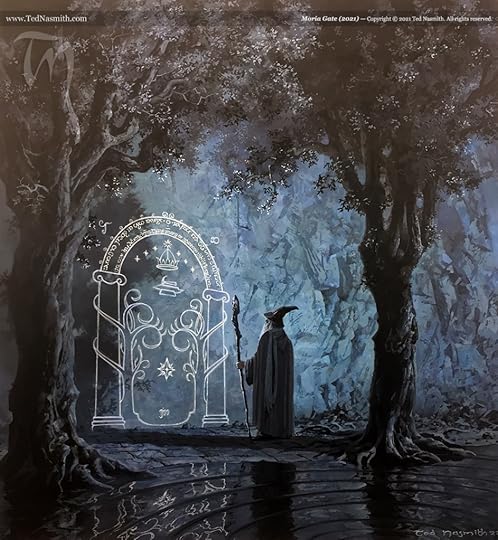
At this point in Tolkien’s history, there was no rift between the Elves and the Dwarves. Instead, the showrunners rely on the play between Gimli and Legolas to inform the audience of interracial conflict rather than showing the history.
The show also has a scene where Prince Durin throws a piece of newly mined Mithril to the end of a table next to a wilted leaf. The Mithril seemed to bring the leaf back to life, which was supposed to indicate how the Mithril would bring back both life to the world and nature to the Elves, but this was not the case in the book.
Tolkien intended to be vague in his writing and wanted an eventual rift between these two races because that created more drama. But, unfortunately, the showrunners are taking it a step further and dramatizing things that were never written to get more dramatics out of the show itself.
Beyond that, Mithril is just a metal. It’s a precious and rare metal, but it doesn’t have the magical power the show pre-supposes. What it does have is the ability to be a magical conduit, which is why Celebrimbor used it in the magical lock of the doors to Moria.
So the argument that King Durin is proposing to his son seems like a dangerous and backward-thinking proposition, but it’s spot on (at least in the show’s reality).
He tells his son, “The Fate of the Elves was decided many ages ago. By minds much wiser, much farther seeing than our own. Defy their will, and this entire kingdom might fall. Perhaps the entire Middle-earth.”
He is alluding to the Valar and how the deeper the Dwarves delve, the more danger they can bring upon themselves. In fact, one of the most well-known Balrogs was named Durin’s Bane.
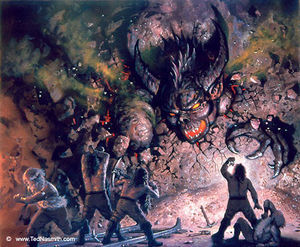
If you remember Peter Jackson’s movies, there is a scene right before the Balrog comes out, and Gandalf says that the Dwarves delve too deep, in their greed. This anticipation of the Balrog is what the showrunners are trying to set up.
There are two other plotlines the show covers, and neither has any basis in Tolkien’s works, just the vague understanding of what might be happening behind and between the pages, with some outright falsehoods along the way.
Let’s get the falsehoods out of the way first, shall we?
Galadriel and Theo are speaking one night on their trek to find survivors of the volcanic explosion. Galadriel tells Theo that she lost her brother Finrod and her husband Celeborn to Sauron. There is no truth in these statements; her story of how she met Celeborn is convoluted with the tale of Beren and Lúthien. That is the story of Lúthien dancing in a meadow and Beren coming upon her, not how Galadriel meets Celeborn. To top that off, Celeborn doesn’t die; we see him in Fellowship of the Rings, so I’m not sure what they are trying to prove here.
In addition, Finrod died in the battle against the Dark Lord, but not the Dark Lord you might think. Finrod had one of the most epic battles told in The Silmarillion when he fought Morgoth, the fallen Valar and Sauron’s master. Sauron had nothing to do with Finrod’s death, so it seems strange that they would purposefully change history instead of just skewing it in their favor.
We also follow along with the Southlanders as they all come together, and we learn of Isildur’s death…which never happens in the book. Isildur’s closest brush with death comes when he steals the fruit from Nimloth, the tree of the Valar, when he still lived on Númenor, and even then, he is never considered dead.
Beyond these blatant changes, however, they do show what happened in history. The Southlands became Mordor, just not in the way the showrunners are proposing. Sadly, we don’t get to see Isildur and his brother develop the great cities of Middle-earth and bypass everything to get some fake fan service, but these are differing mediums, so I guess beggars can’t be choosers. You either get screen time in the Second age or don’t.
The last portion I would like to mention is the powerful magical strangers who come across the halflings. There is much mention that this is Sauron, but I don’t think that’s the case. Instead, I think this may be a younger version of Saruman or one of the other Istari.
Sauron didn’t travel in a group. Indeed he was famously solitary and did not need to mess with halflings. But then again, they have changed many other things, so let’s see where the ride takes us.
Join me next week as we delve back into The Silmarillion for the Penultimate essay on Of The Rings of Power and the Third Age before coming back for the final episode of The Rings Of Power!



